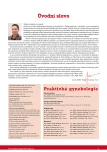Perimenopausal obesity and how to approach it
Authors:
P. Šrámková
Authors‘ workplace:
OB klinika Praha, Endokrinologický ústav Praha
Published in:
Prakt Gyn 2010; 14(1): 42-47
Category:
Review Article
Overview
The prevalence of overweight and obesity has reached pandemic proportions. Obesity is caused by the imbalance between energy intake and expenditure, on a significant genetic background. The prevalence of overweight in perimenopausal population is 66 %, out of which 35 % of women are obese. During perimenopause, the physiological energy intake requirement is 1/ 3 lower than at 25 years of age, however, women generally do not decrease their portions, continue with traditional Czech cuisine rich in fats, many women start comfort eating. Other contributing factor is a lack of exercise. The cause of perimenopause is physiological hormonal changes which can lead to the development of metabolic syndrome – the key risk factor of cardiovascular disease. The risk is increased 4 - fold [6 – 7]. Treatment of obesity in perimenopause is more difficult and the achieved weight loss is smaller than in younger women. Oftentimes we are satisfied with just weight maintenance. The goal is to reduce weight by 5 – 10 %. This is achieved with lifestyle change, including diet and exercise modifications. We also use effective pharmacotherapy - sibutramine and orlistat - whilst respecting their contraindications. Bariatric surgery is indicated for patients with BMI ≥ 35 and comorbidities, or BMI ≥ 40, under the age of 65. Its efficacy is high, over 80 % of patients achieve weight reduction of 15 – 25 % and more of initial weight. Long term efficacy in Loir weight maintenance is also documented, as well as improvement or disappearance of concomitant diseases, reduction in medication and increased life expectancy.
Key words:
obesity – toxic environment – waist circumference – obesity treatment – weight – loss diet – pharmacotherapy – exercise – psychotherapy – bariatric surgery
Sources
1. Rankinen T, Zuberi A, Chagnon YC et al. The human obesity gene map: the 2005 update. Obesity (Silver Spring) 2006; 14(4): 529 – 644.
2. Kushner RF, Bessesen DH. Treatment of the obese patient (contemporary endocrinology). Obesity: epidemiology, pathophysiology and prevention. New Jersey: Humana Press 2007.
3. Walsh MC, Hunter GR, Livingstone MB. Sarcopenia in premenopausal and postmenopausal women with osteopenia, osteoporosis and normal bone mineral density. Osteoporosis Int 2006; 17(1): 61 – 67.
4. Gruber J, Frakes M. Does falling smoking lead to rising obesity? J Health Econ 2006; 25(2): 183 – 197.
5. John U, Hanke M, Rumpf HJ. Smoking status, cigarettes per day, and their relationship to overweight and obesity among former and current smokers in a national adult general population sample. Int J Obes 2005; 29(10): 1289 – 1294.
6. Schenck - Gustaffson K. Diagnosis pf cardiovascular disease in woman. Menopause International 2007; 13(1): 19 – 22.
7. Wilson PW. Estimating cardiovascular disease risk and metabolic syndrome: a Framingham view. Endokrinol Metab Clin North Am 2004; 33(3): 467 – 481.
8. Simkin‑Silverman LR, Wing RR. Weight gain during menopause. Is it inevitable or can it be prevented? Postgrad Med 2000; 108(3): 47 – 50.
9. van Dis I, Kromhout D, Geleijnse JM et al. Body mass index and waist circumference predict both 10‑year nonfatal and fatal cardiovascular disease risk: study conducted in 20 000 Dutch men and women aged 20 – 65 years. Eur J Cardiovasc Prev Rehabil 2009; 16(6): 729 – 734.
10. World Health Organiztion, 2005. Available from: <http:/ / apps.who.int/ whosis/ database/ mort/ table1_process.cfm>.
11. Ústav zdravotnických informací a statistiky ČR. Česká republika: Novotvary 2005.
12. Fried M, Hainer V, Basdevant A. Interdisciplinary European guidelines for surgery for severe (morbid) obesity. Obes Surg 2007; 17(2): 260 – 270.
13. Tsigos C, Hainer V, Basdevant A. Management of obesity in adults: European clinical practice guidelines. Obes Facts 2008; 1(2): 106 – 116.
14. Subak LL, Whitcomb E, Shen H et al. Weight loss: A Novel and effective treatment for urinary incontinence. J Urol 2005; 174(1): 190 – 195.
15. James WP, Astrup A, Finer N et al. Effect of sibutramine on weight maintenance after weight loss: a randomised trial. STORM Study Group. Sibutramine Trial of obesity Reduction and maintenance. Lancet 2000; 356(9248): 2119 – 2125.
16. Torgerson JS, Hauptman J, Boldrin MN et al. XENical in the prevention of diabetes in obese subject (XENDOS) study: a randomized study of orlistat as an adjunct to lifestyle changes for the prevention of type 2 diabetes in obese patients. Diabetes Care 2004; 27(1): 155 – 161.
17. Rubino F, Kaplan LM, Schauer PR et al. The Diabetes Surgery Summit Consensus Conference: Recommendations for the Evaluation and Use of Gastrointestinal Surgery to Treat Type 2 Diabetes Mellitus. Ann Surg 2009. Epub ahead of print.
18. Sjöström L, Narbro K, Sjöström CD et al. Effects of bariatric surgery on mortality in Swedish obese subjects. N Engl J Med 2007; 357(8): 741 – 752.
19. Cífková R, Býma S, Češka R et al. Prevence kardiovaskulárních onemocnění v dospělém věku. Společné doporučení českých odborných společností. Cor Vasa 2005; 47(9 Suppl.): 3 – 14.
Labels
Paediatric gynaecology Gynaecology and obstetrics Reproduction medicineArticle was published in
Practical Gynecology

2010 Issue 1
Most read in this issue
- Margin status of conizations with histological finding carcinoma in situ
- ICTP marker and breast cancer with bone metastases – our experience
- Intrahepatic cholestasis of pregnancy – selected perinatal outcomes.
- Therapeutic options for assisted reproduction in patients with impaired ovarian reserve
